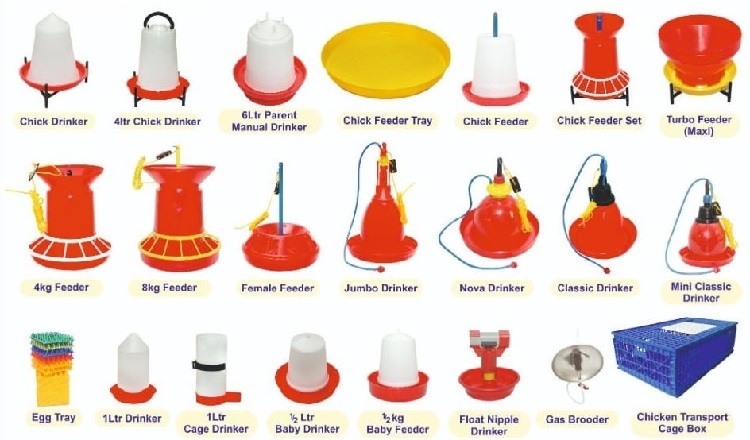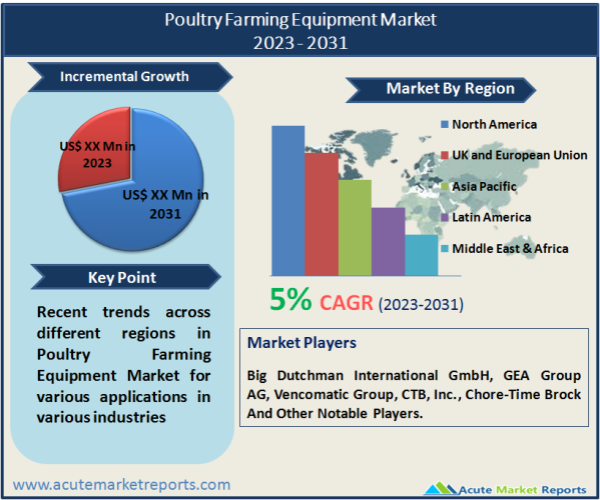
The poultry farming equipment market has been experiencing substantial growth in recent years. According to industry reports, the market revenue reached a significant figure and is expected to continue its upward trajectory in the coming years. The increasing demand for poultry products, such as meat and eggs, coupled with the need for improved efficiency and productivity in poultry farming operations, has been driving the market growth. Poultry farming equipment plays a crucial role in enhancing the overall productivity, welfare, and health of poultry birds. The equipment includes various components such as feeding systems, drinking systems, ventilation systems, lighting systems, egg handling systems, waste management systems, and monitoring and controlling systems. These equipment solutions are designed to provide optimal environmental conditions, efficient management of feed and water, disease prevention, and effective waste management.The market is expected to witness a steady CAGR of 5% during the forecast period of 2025 to 2033. Firstly, the growing global population and rising disposable incomes have resulted in increased consumption of poultry products, driving the demand for poultry farming equipment. Moreover, the shift towards intensive poultry farming practices and the adoption of automated equipment solutions have contributed to the market growth. Farmers are increasingly investing in modern equipment to maximize their productivity, reduce labor costs, and ensure the welfare and health of the poultry birds.

Increasing Demand for Poultry Products
The growing global population and rising disposable incomes are driving the demand for poultry products, including meat and eggs. Poultry products are a rich source of protein and are consumed widely across various regions and cultures. According to the Food and Agriculture Organization (FAO) of the United Nations, the global meat consumption per capita has been steadily increasing, with poultry meat being one of the fastest-growing segments. This increasing demand for poultry products is a key driver for the poultry farming equipment market as farmers strive to meet the growing market requirements.
Shift towards Intensive Poultry Farming
There has been a notable shift towards intensive poultry farming practices due to their higher productivity and efficiency compared to traditional extensive farming methods. Intensive poultry farming involves the use of controlled environments, automated systems, and advanced equipment solutions to maximize output and minimize costs. Farmers are increasingly adopting intensive farming practices to optimize space utilization, enhance feed efficiency, and ensure better disease control. This shift towards intensive poultry farming is driving the demand for poultry farming equipment, including feeding systems, ventilation systems, and automated monitoring and controlling systems.
Technological Advancements in Equipment Solutions
Technological advancements have significantly contributed to the development of innovative poultry farming equipment solutions. The integration of advanced technologies such as sensors, automation, and data analytics has revolutionized poultry farming practices. For example, modern feeding systems use automated feeders that precisely deliver the right amount of feed, reducing waste and ensuring optimal nutrition for poultry birds. Ventilation systems are equipped with sensors and controls that maintain optimal temperature and air quality inside poultry houses. These technological advancements enhance operational efficiency, improve animal welfare, and enable farmers to monitor and manage their poultry farming operations more effectively.
High Initial Investment Cost
One of the significant restraints faced by the poultry farming equipment market is the high initial investment cost associated with setting up and maintaining the equipment. Poultry farming equipment, such as automated feeding systems, ventilation systems, and monitoring and controlling systems, require substantial upfront investments. Farmers need to invest in the purchase and installation of equipment, infrastructure development, and electrical and plumbing systems. Additionally, ongoing maintenance and operational costs also contribute to the financial burden. The high initial investment cost can act as a barrier, particularly for small-scale farmers or those operating in regions with limited financial resources. This restraint can limit the adoption of advanced equipment solutions and hinder the overall growth of the poultry farming equipment market. However, it is important to note that while the initial investment cost may be high, the long-term benefits and potential returns on investment in terms of improved productivity, efficiency, and animal welfare often outweigh the initial financial constraints. Farmers need to carefully evaluate their budget and consider the long-term advantages of investing in modern poultry farming equipment to make informed decisions.
The Automatic Mode of Operations Dominated the Revenues for Markey by Mode of Operation
The poultry farming equipment market offers different modes of operation, including manual, semi-automatic, and automatic systems. The automatic mode of operation is expected to witness the highest CAGR during the forecast period of 2025 to 2033and generated the highest revenue in 2024 in the market. Automatic poultry farming equipment provides advanced features and automation capabilities that enhance operational efficiency, reduce labor requirements, and improve overall productivity. These systems are designed to automate various tasks such as feeding, watering, egg collection, and waste management. They incorporate sensors, timers, and control systems to monitor and regulate environmental conditions inside the poultry houses. The automatic mode of operation enables precise control over feed distribution, ensuring optimal nutrition for poultry birds. It also facilitates the efficient management of water supply, ventilation, and lighting, creating a favorable environment for the birds' growth and well-being. The increasing adoption of automatic poultry farming equipment can be attributed to its ability to streamline operations, minimize human error, and optimize resource utilization. Farmers are recognizing the benefits of automation in improving farm efficiency, reducing costs, and maximizing overall profitability. As a result, the automatic mode of operation is expected to experience robust growth in the poultry farming equipment market, both in terms of revenue generation and CAGR.
Indirect Sales Dominated the Market by Distribution Channel
The poultry farming equipment market encompasses two primary distribution channels: direct sales and indirect sales. While both distribution channels contribute to the market's growth, indirect sales are expected to exhibit the highest CAGR during the forecast period of 2025 to 2033 and generated the highest revenue in 2024. Indirect sales involve the distribution of poultry farming equipment through intermediaries such as distributors, dealers, and retailers. These intermediaries have established networks and relationships with farmers, providing them with a convenient and accessible way to procure the required equipment. Indirect sales offer several advantages, including a wider reach, efficient logistics, and localized support and service. Distributors and dealers act as a bridge between equipment manufacturers and end-users, providing value-added services such as installation, maintenance, and after-sales support. Moreover, indirect sales channels benefit from economies of scale as they cater to a broader customer base, enabling manufacturers to reach more customers without extensive investments in sales infrastructure. On the other hand, direct sales involve manufacturers selling their poultry farming equipment directly to farmers. This channel allows manufacturers to have direct control over the sales process, customer relationships, and brand image. Direct sales are typically conducted through company-owned stores, online platforms, or through a dedicated sales force. While direct sales provide manufacturers with a higher level of control and direct customer feedback, it may require significant investments in marketing, sales operations, and customer service.
North America Remains as the Global Leader
North America, led by the United States, has been a prominent market for poultry farming equipment due to the high consumption of poultry products and the presence of large-scale commercial poultry farms. The region has witnessed significant investments in advanced equipment and technologies to improve productivity and meet consumer demands for high-quality poultry products. Europe is another key market for poultry farming equipment, with countries like Germany, France, and the United Kingdom at the forefront. The region emphasizes sustainable and welfare-oriented farming practices, driving the demand for equipment that ensures optimal conditions for poultry birds. Asia Pacific has witnessed rapid growth in the poultry farming equipment market, particularly in countries like China and India, due to the increasing population, urbanization, and changing dietary preferences. These factors have fueled the demand for poultry products and led to the adoption of modern equipment solutions to enhance productivity. The Middle East and Africa region also show potential for market growth, driven by the rising demand for poultry products and the focus on food security. Within these regions, the highest CAGR is expected in Asia Pacific, fueled by the growing population, expanding poultry industry, and increasing investments in modern equipment.
Market Competition to Intensify during the Forecast Period
The poultry farming equipment market is highly competitive, with several players vying for market share. The market is characterized by the presence of both global and regional players, each striving to offer innovative and technologically advanced equipment solutions. Some of the top players in the market include Big Dutchman International GmbH, GEA Group AG, Vencomatic Group, CTB, Inc., and Chore-Time Brock, among others. These companies have established themselves as key players through their extensive product portfolios, technological expertise, and strong distribution networks.To maintain a competitive edge, companies in the poultry farming equipment market are adopting various strategies. One of the key strategies is focused on research and development to introduce innovative products that address the evolving needs of poultry farmers. Manufacturers are investing in advanced technologies, such as automation, sensors, and data analytics, to develop equipment solutions that enhance efficiency, animal welfare, and overall farm productivity. Moreover, companies are also emphasizing sustainability in their product offerings, with a focus on energy-efficient systems, waste management solutions, and environmentally friendly materials.
Historical & Forecast Period
This study report represents analysis of each segment from 2023 to 2033 considering 2024 as the base year. Compounded Annual Growth Rate (CAGR) for each of the respective segments estimated for the forecast period of 2025 to 2033.
The current report comprises of quantitative market estimations for each micro market for every geographical region and qualitative market analysis such as micro and macro environment analysis, market trends, competitive intelligence, segment analysis, porters five force model, top winning strategies, top investment markets, emerging trends and technological analysis, case studies, strategic conclusions and recommendations and other key market insights.
Research Methodology
The complete research study was conducted in three phases, namely: secondary research, primary research, and expert panel review. key data point that enables the estimation of Poultry Farming Equipment market are as follows:
Market forecast was performed through proprietary software that analyzes various qualitative and quantitative factors. Growth rate and CAGR were estimated through intensive secondary and primary research. Data triangulation across various data points provides accuracy across various analyzed market segments in the report. Application of both top down and bottom-up approach for validation of market estimation assures logical, methodical and mathematical consistency of the quantitative data.
| ATTRIBUTE | DETAILS |
|---|---|
| Research Period | 2023-2033 |
| Base Year | 2024 |
| Forecast Period | 2025-2033 |
| Historical Year | 2023 |
| Unit | USD Million |
| Segmentation | |
Type
| |
Mode Of Operation
| |
Poultry Type
| |
Distribution Channel
| |
|
Region Segment (2023-2033; US$ Million)
|
Key questions answered in this report